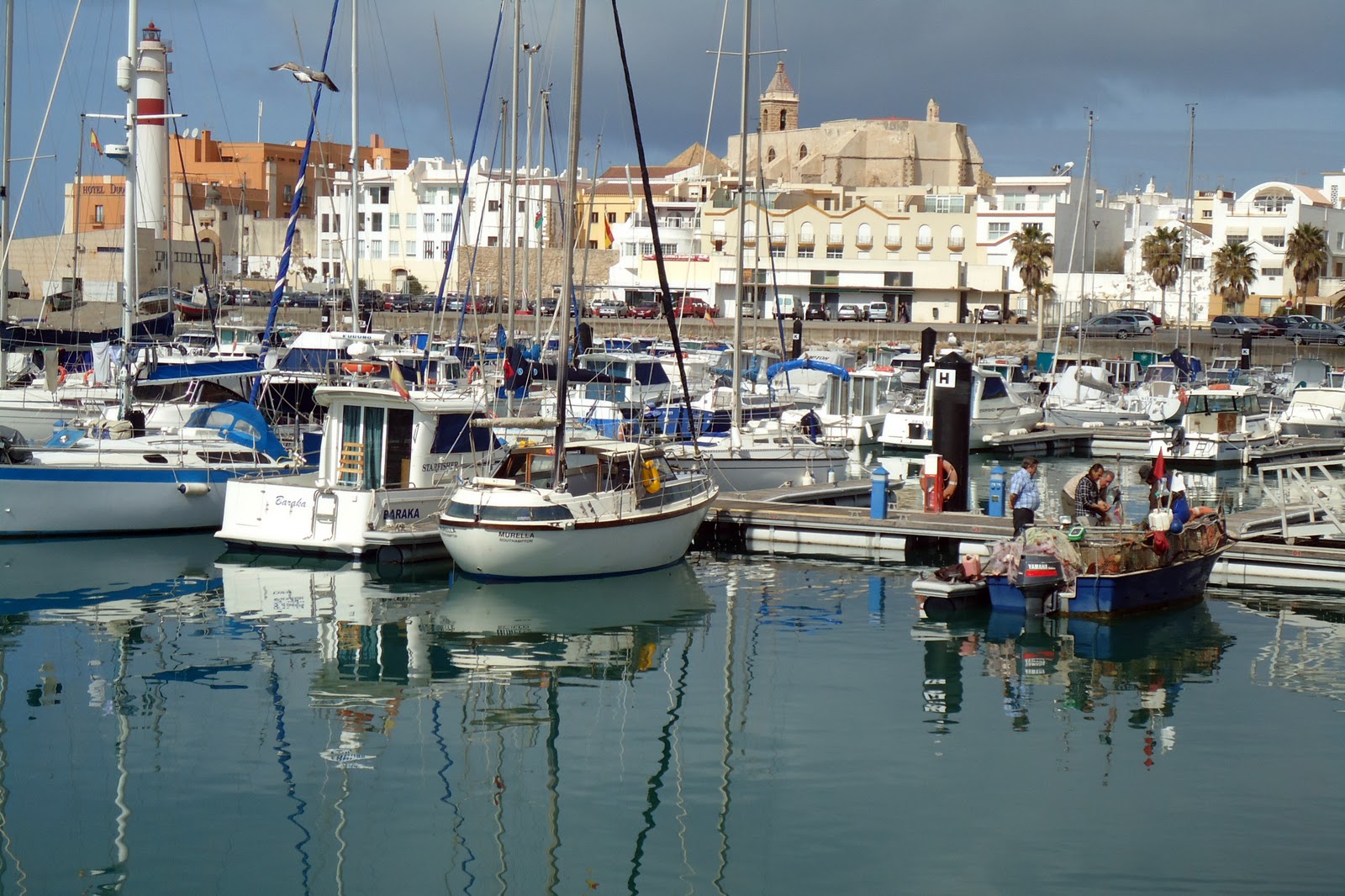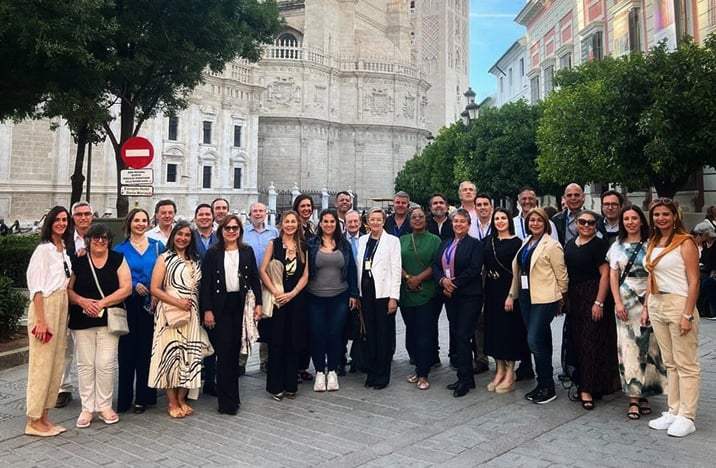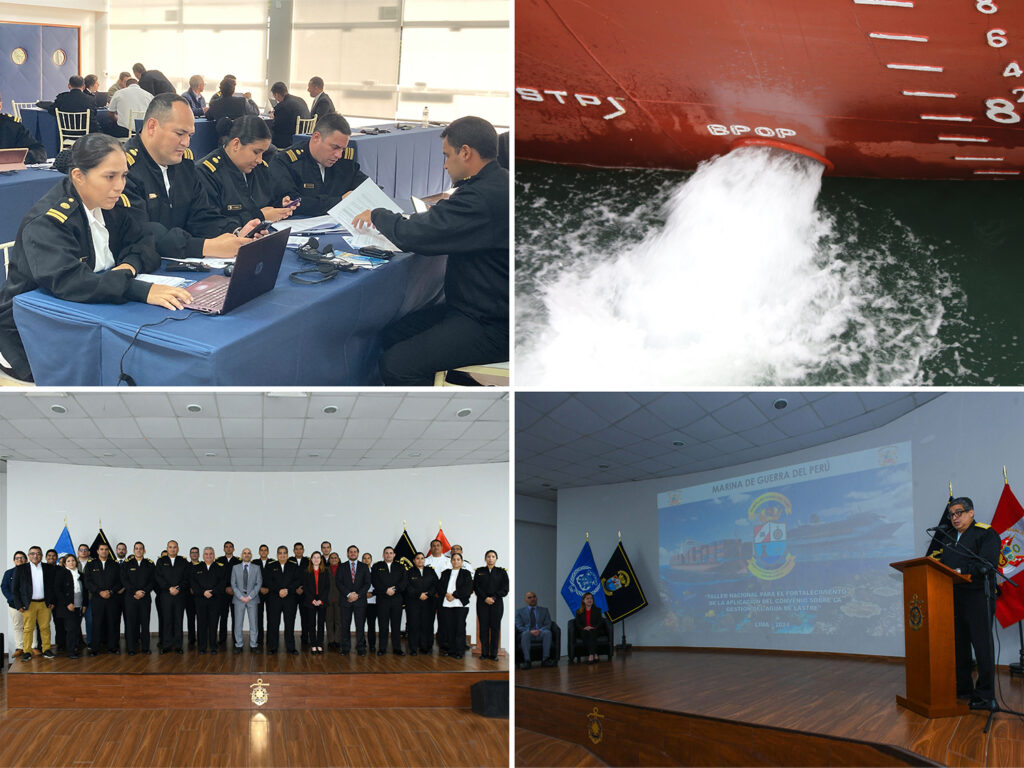A delegation of Latin American port leaders undertook a discovery trip to the most innovative ports in Spain, with the aim of exploring success stories and seeking inspiration for the future development of port infrastructure in Latin America.
The Port Leaders initiative contributed to the consolidation of ties and to promote international cooperation between the ports of the two continents, offering participants a unique experience to establish a constructive dialogue and promote business opportunities.
Sustainable development.
The crossing began in the Port of Huelva, strategically located in southwestern Spain, just 100 nautical miles from the Strait of Gibraltar.
The delegation was received by its President, Alberto Santana Martínez, and Director General Ignacio Álvarez-Ossorio Ramos, who shared the Port’s vision and achievements in terms of energy transition and sustainable development.
Participants were impressed to learn of the ambitious investment plan, which exceeds 240 million euros for the period 2022-2026, with a clear focus on the promotion of clean fuels and environmental sustainability.
Improve efficiency

One of the most striking aspects of the visit was the time when the tour of the 17 km of coastal edge was carried out and it was possible to appreciate the operation of the port infrastructure of Huelva, the efficiency and modernity of the facilities, which the attendees recognized as a model to replicate in their own ports to improve efficiency and competitiveness in international trade.
Operational capabilities
The infrastructure stands out for its specialized liquid and solid bulk terminals, as well as a Logistics Activities Zone (ZAL) that expands its operational capabilities. In addition, the connectivity of the port is exceptional, with excellent railway and maritime connections that facilitate the fluid movement of goods and reduce congestion.
Port of Huelva
Always moving forward and committed to technological innovation, the Port of Huelva works on initiatives such as the Digital Transformation Plan 2021-2025 and the Technological Innovation Node, seeking to integrate all stages of innovation and promote digitization and sustainability.
In numbers, this port demonstrates its importance and operational capacity. In 2023, it handled a total of 30,078,896 tons of goods, highlighting in bulk liquid and solid bulk, as well as in general merchandise.
A key player
Its position in both Spain and Europe places it as a key player in global trade, with a constantly developing infrastructure and a firm commitment to sustainability and innovation, committed to a cleaner and more efficient future for all.
From Huelva, the delegation continued its journey to the Port of Seville, located in the heart of a metropolitan area with 1.5 million inhabitants.
The reception was led by President Rafael Carmona, CEO Ángel Pulido and Propeller President Mercedes Valdivia, who were in charge of presenting the operational capacity and advanced infrastructure of the port.
It was a moment of great interest to the audience, as they were able to learn about the innovative approach of that Harbour Authority towards digital transformation and environmental sustainability.
Port of Seville

The Port of Seville is characterized by its advanced infrastructure, which includes a railway terminal with five tracks for trains of up to 750 meters, more than 5,000 meters of dock line, 19 cranes, 50 km of internal roads, 30 km of railways, 200,000 m2 of storage in logistics ships and 80,000 m3 in refrigerated storage.
In addition, the Harbour Urban District, with 57 hectares, facilitates integration between the port and the city.
Annual traffic
With an annual traffic of 3.9 million tons of goods and 165,764 TEU (conenetors), the port is consolidated as an essential logistic node.
The regular shipping lines connect Seville with the Canary Islands and West Africa, operated by companies such as BOLUDA and CMA-CGM. Its rail links ensure connectivity with Madrid, Bilbao and Valencia, facilitating the transport of agri-food and steel products.
Strategic Plan 2025 of the Port of Seville provides for investments of 60 million euros between 2024 and 2027 to improve navigation, railway infrastructure and energy efficiency.
Investments
These investments include the construction of new terminals and ships for the agri-food and logistics sector, the development of an Innovation Center and the reordering of port spaces.
In terms of digitization and sustainability, the port is implementing advanced technologies such as FPS II and IRAIL, along with sustainable dredging and sediment management techniques, and energy efficiency projects such as PAHO (Onshore Power Supply). These efforts are aligned with their commitment to environmental sustainability.
Harbour Urban District
In addition, the port works on improving the relationship with the city through projects such as the Harbour Urban District, which seeks to reorder and revitalize port spaces to transform them into accessible urban areas.
Investments in areas such as El Cuarto and Zona Franca are designed to encourage the mixed use of these areas.
Technological transformation and sustainability are fundamental pillars for the port, which is developing a digital twin and a Technological Innovation Node to promote collaboration between the port and the local community.

The next stop was the Port of the Bay of Cadiz, a fundamental pillar of the economic development of that region.
Chaired by Teófila Martínez Saiz, this port is not only a connecting point between three continents, but also a center of business and tourist activity that drives local and national growth.
Andalusian port
With a modern infrastructure and an enviable operational capacity, this port has five dol dollforms distributed in three municipalities:
Cadiz, Cabezuela-Puerto Real and El Puerto de Santa María. Its vast area of 4.2 million square meters in the public domain houses 264 companies operating in its facilities, handling a total traffic of 5.7 million tons of goods per year.
Highlighting in the cruise sector, the port receives about 350 stopovers per year, attracting about 700,000 passengers, which positions it as the second peninsular port in this segment. In addition, its contribution to the fishing sector is remarkable, with 12,000 tons of fresh fish per year, being the first Andalusian port and the fifth at national level in this area.
Port of the Bay of Cadiz

In terms of sustainability, thePort of the Bay of Cadiz is at the forefront, committing to emission reduction, energy efficiency and responsible waste management.
These measures not only protect the environment, but also promote more sustainable and balanced economic development. Some of these measures include:
Reducing emissions: The port is working to reduce greenhouse gas and other polluting emissions by implementing cleaner charging and shipping technologies.
Energy efficiency: Projects are under way to improve energy efficiency in port facilities, using technologies such as LED lighting, energy management systems and renewable energy.
Waste management:
Prevent pollution
Waste management programmes are being implemented to reduce the amount of waste generated in the port and promote recycling and reuse whenever possible.
Protection of marine biodiversity: Action is being taken to protect and preserve marine biodiversity in and around the port, such as the creation of conservation areas and the implementation of measures to prevent pollution.
Promoting sustainable transport: More sustainable modes of transport, such as short sea shipping and port connection to public transport networks, are being promoted to reduce road transport dependence.
The trip ended at the Port of Algeciras, located on the southern coast of Spain, in the Strait of Gibraltar.
Here, the delegation had the opportunity to talk with its President Gerardo Landaluce, as well as with the main directors of the institution, who presented the strategic pillars of the Port Authority, based on operational excellence and technological innovation, which have made it one of the most efficient in Europe.
Innovation strategy
The innovation strategy of the Port of Algeciras ranges from reducing operational costs and waiting times, to improving visibility and real-time planning, all driven by cutting-edge technologies such as artificial intelligence and data analysis.
A digital platform has been successfully implemented to orchestrate the complex port ecosystem, promoting collaboration among all the actors involved and optimizing the management of resources and operations.
Many initiatives
Highlighting among the many initiatives implemented, the reduction of waiting times and emissions has been a remarkable achievement. “Just in Time” strategies have allowed the port to reduce the waiting time for ships by 12% and emissions by 10%, demonstrating its commitment to more efficient and sustainable operation.
The Port of Algeciras is also proud to be the first certified port authority in R & D policies and open innovation framework, consolidating its reputation as a leader in innovation within the sector.
APBA
APBA is also playing a crucial role in transforming towards sustainability, driving an ambitious “Green Strategy 2030” based on international and European standards.
With a focus on carbon neutrality, the Port Authority actively promotes the use of low-carbon technologies and responsible environmental management.
Commitment to sustainability and innovation does not stop here. The port is actively participating in the European Port Alliance initiative, an alliance aimed at strengthening port security in the EU.
Port of Algeciras

Through this collaboration, the aim is to modernise customs equipment and promote greater cooperation between Member States and various European agencies.
In short, the Port of Algeciras is positioned as an undisputed leader in efficiency and sustainability in the European port sector.
His commitment to innovation and operational excellence makes him an example to be followed for ports around the world, while continuing to play a vital role in the regional and global economy.
Source: PR PORTS




